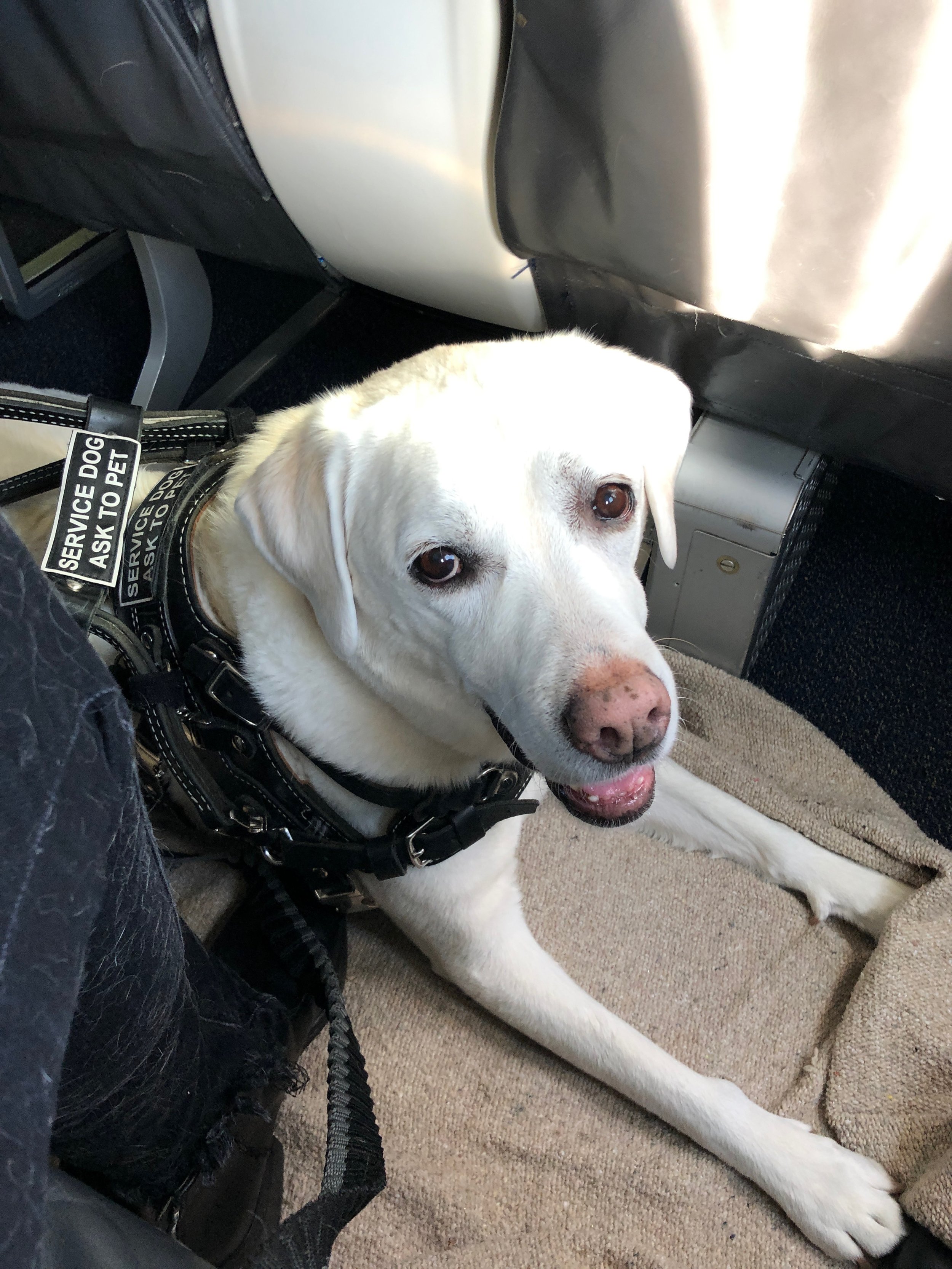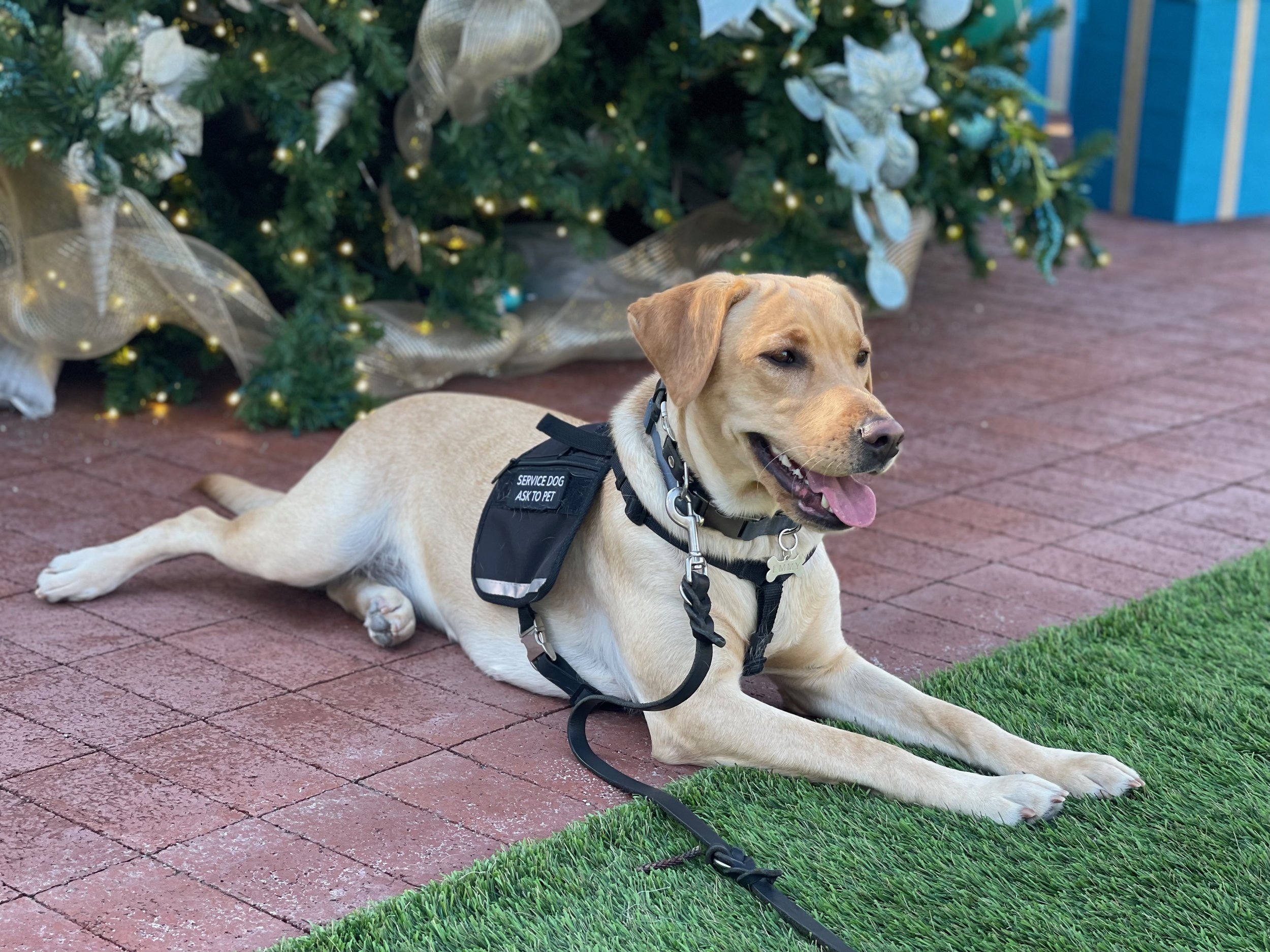SERVICE DOGS
MY SERVICE DOG JOURNEY
Just prior to my second surgery for removal of a 4cm acoustic neuroma, I found out that I would qualify under the ADA twice (for vestibular deficiency and single-sided deafness). Having two great dogs as pets, I chose my younger Labrador, Daisy, for the service dog job over my very sweet (but somewhat timid) Golden Retriever, F.R.E.D. Two weeks after coming home from the hospital, Daisy and I began with a weekly group basic obedience class and twice weekly private sessions with a specialized Public Access trainer in Los Angeles, California.
Daisy thrived on the work, and it was a great way for me to embrace these new disabilities in a positive way. Three months later, my family and I took a trip, and Daisy was not ‘Service Dog ready’ to fly, so I left her at home. I had noticed improvements in my balance on our canyon hikes, but I had not spent any real amount of time in public spaces as I still had a friend helping me with shopping and daily life at the time. There was a part of me that questioned if I was “just wanting to have my dog with me everywhere,” like maybe I was taking advantage of the ADA. But then I stepped onto the curb at LAX and the whole world spun around me until I finally reached my seat on the plane and sat down. During that half hour, I felt overwhelmed by dizziness and nausea. And experiencing the airport through the cacophony of sound through only one ear, I decided to keep working with Daisy to become my Mobility Service Dog to make getting around in the world easier and less stressful.
Our sessions together with our trainer became such a blessing. They were so much fun that I looked forward to them, and I have learned a great deal about what it means to be out in the world with a Mobility Service Dog. There is an etiquette that only comes from Service Dog task and Public Access training, so it is difficult for me on a personal level when we encounter people masquerading their pets in ‘service dog’ gear and taking them into the public space without those earned qualifications (or genuine need). I try to use these moments as ones to educate, but honestly, I do get triggered sometimes. I want to say to people who put ‘service dog’ gear on their retractable-leashed, aggressive, lunging, and barking dogs that they are violating Federal Law and making it dangerous and more difficult for me and others. But the truth is, people who do this are either unscrupulous (and can’t be helped to change or reconsider their potentially harmful actions) or they are misinformed about what a Service Dog is, have no idea about the training required for task-trained Service Dogs, and do not realize how difficult they make it for legitimate Service Dog teams by choosing to take their pet (or ESA) into the public space where pets are generally not allowed.
I have countless stories of encountering dogs in the public space, both positive and negative, and what I think most people don’t realize is that a Service Dog is a full-time commitment of highly-specialized training and lifelong, mandatory effort. Aside from the tasks to mitigate individual disabilities a dog must learn, a Service Dog must be able to do these tasks in the midst of public distractions. And the entire public space is one giant distraction — cars, people on skateboards and bicycles, food, building cranes, trash on the ground, a person sweeping the sidewalk, and other dogs — these are just a few common aspects of the public space that the average person doesn’t think about with any amount of detail. Anyone who observes legitimate working Service Dog teams will immediately notice the behavior of the dog and how focused it is on their person. If you’re paying attention, it is easy to spot those who are masquerading their pets in ‘service dog’ gear.
Now that Daisy is fully retired from her Service Dog role, I have trained my second Service Dog, Emmy, who is doing a great job growing in her role! It has been such an awesome experience raising a Service Dog candidate from an eight-week old puppy! She has already taught me so much, and I continue to acquire new training skills with her every single day. Emmy was not my first candidate for my second Service Dog. I adopted a Smooth Collie, named T.E.D., who is darling and so amazingly smart, but sadly, he experiences motion sickness in cars. He is better now that he is an adult, but asking him to do the rigorous job of daily tasks in the public space would have been unethical and unkind, so I career-changed him to pet when he was just six months old. He loves Agility tasks, and he also helps me at home with certain Mobility and Hearing-Alert tasks. As I have been training Emmy, taking her nearly everywhere with me post-pandemic around Los Angeles, it has become apparent to me how much has changed with dogs in the public space (at least in the area where we have been recently). So many people have their pet dogs with them - in areas that pet dogs should never be (grocery stores). So many people want to say hello and allow their dogs to say hello to Emmy while she is working, ignoring her vest identifying her as a Service Dog. It is a constant challenge to be polite and to educate, and I must admit, I do not always succeed with the grace and poise I strive to maintain when out in public with Emmy. I love that dogs bring so much joy to people, but there is also an etiquette that the general public should follow when encountering a Service Dog. I love it when I see a Mom or a school teacher saying to their children, “Oh look at that Service Dog! She is working hard, so let’s not distract her so she can do her job.”
WHAT IS A SERVICE DOG?
So what is a Service Dog anyway? The ADA defines a service animal as: a dog that has been individually trained to do work or perform tasks for an individual with a disability. The task(s) performed by the dog must be directly related to the person's disability. The dog must be trained to take a specific action when needed to assist the person with a disability. For example, a person with diabetes may have a dog that is trained to alert her when her blood sugar reaches high or low levels. A person with depression may have a dog that is trained to remind him to take his medication. Or, a person who has epilepsy may have a dog that is trained to detect the onset of a seizure and then help the person remain safe during the seizure.
In my case, I employ a fully-trained Mobility Service Dog. Daisy is now retired and Emmy has grown to take on the working role. She mitigates my disability by helping to stabilize my vestibular system (my balance) through guiding and bracing as well as alerting me to curb level changes, taking stairs slowly, and slowing me down when she notices I am becoming dizzy. She is brilliant, and I feel so much more safe and confident going about daily life with her help. I have noticed a lot of people (some of my friends even) not recognizing the difference between a Service Dog as defined by the ADA and an Emotional Support Animal (ESA), a Therapy Dog, Facility Dog, or Companion Animal. I realize how confusing it can be, especially when people so very much love their dogs and want them near them. But when an untrained animal is in the public space, it creates a potentially dangerous hazard for a working Service Dog team and for those around them.
With the help of a professional trainer with experience training dogs in Public Access and task training, I have learned how to train my dog for my needs (my specific tasks to mitigate my balance issues), how to navigate the public space efficiently, and how to have patience and grace with Emmy, myself, and others. No dog is 100% perfect, outside of a Guide Dog for a person with a vision impairment — the dogs trained to assist a blind person, aka a Guide Dog, must have a level of perfection that is very difficult to attain outside of a formal program (like the program at Guide Dogs for the Blind, for example). A Guide Dog must reach a level of proficiency that includes what is called intelligent disobedience. Intelligent disobedience is the term used when a dog ignores a command given by its blind handler if it will put the team in harm’s way. Only the best of the best make it to this level. If you are interested to learn more about Guide Dogs for the Blind, watch Pick of the Litter on Disney+ about the process of a dog going from puppy to working Guide. It is fascinating and heartwarming.
When I trained and worked with Daisy, she reached a level of proficiency that mitigated my vestibular disability 98% of the time. We took almost a year off of being in the public space because of the pandemic, and once getting vaccinated, I was able to feel more confident about going out in the world with her again. We had to brush up on her skills, but like riding a bike — she dropped right in after a few outings. Working with Daisy has been one of the most rewarding experiences of my life. Watching her grow, transform, and succeed has created memories that I will cherish for the rest of my life, especially now that she is formally retired from working in the public space.
In 2021, I adopted Emmy at eight-weeks old from Gochee Labradors in Sherrard, Illinois. The Gochee family is simply the finest, and they have excellent breeding stock for Service Dog candidates, hunting dogs, and family companions. The entire family takes part in the program, and each bring their own brand of love and skill to the process. Utilizing several curriculums (Puppy Culture, Empowered Breeder, and Avidog) to give their puppies the best start in life, the Gochee Family really gets to know and work with their puppy families (and Service Dog organizations) to make sure the puppies they raise are going to the right places. They have taught me so much through this process of choosing Emmy out of her litter of 13, and I couldn’t be more grateful for their guidance, their sharing of knowledge and experience, their patience, and the love they show each and every puppy. My Sweet Emmeline Jane, aka “Emmy,” arrived pre-programmed with good manners, a schedule, and a zest for learning and affection that is simply amazing to see from an eight-week old puppy. It has been absolutely the best experience I have ever had in adopting a puppy, and she has grown into a fun-loving and helpful partner. She approaches work with enthusiasm, and she is always willing to learn new skills.



